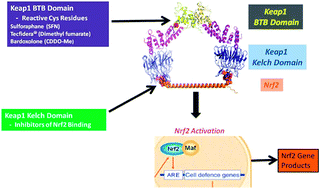Analytical approaches for quantification of a Nrf2 pathway activator: overcoming bioanalytical challenges to support a toxicity study
Abstract
Activation of the Nrf2 stress pathway is known to play an important role in the defense mechanism against electrophilic and oxidative damage to biological macromolecules (DNA, lipids, and proteins). Chemical inducers of Nrf2 such as sulforaphane, dimethyl fumarate (Tecfidera®), CDDO-Me (bardoxolone-methyl), and 3-(dimethylamino)-4-((3-isothiocyanatopropyl)(methyl)amino)cyclobut-3-ene-1,2-dione (a synthetic sulforaphane analogue; will be referred to as 1) have the ability to react with Keap1 cysteine residues, leading to activation of the Antioxidant Response Element (ARE). Due to their electrophilic nature and poor matrix stability, these compounds represent great challenges when developing bioanalytical methods to evaluate in vivo exposure. 1 like SFN reacts rapidly with glutathione (GSH) and nucleophilic groups in proteins to form covalent adducts. In this work, three procedures were developed to estimate the exposure of 1 in a non-GLP 7 day safety study in rats: (1) protein precipitation of blood samples with methanol containing the free thiol trapping reagent 4-fluoro-7-aminosulfonylbenzofurazan (ABD-F) to measure GSH- and N-acetylcysteine conjugated metabolites of 1; (2) an Edman degradation procedure to cleave and analyze N-terminal adducts of 1 at the valine moiety; and (3) treatment with ammonium hydroxide to measure circulating free- and all sulfhydryl bound 1.


 Please wait while we load your content...
Please wait while we load your content...